
First and Only Weekly Online Fanzine Devoted to the Life & Works of Edgar Rice Burroughs
Since 1996 ~ Over 10,000 Web Pages in Archive
presents
Volume 2990


The Teenage Tarzan
A Literary Analysis of Edgar Rice Burroughs' Jungle Tales of Tarzan
by Stan Galloway
with Foreword by James Gunn and cover art by Thomas Yeates
mcfarlandpub.com | Amazon.com
ISBN 978-0-7864-3853-2 ~ softcover 2010 ~ Price: $35.00Following the 1912 publication of his wildly successful Tarzan of the Apes, Edgar Rice Burroughs authored four bestselling sequels in quick succession. In 1916, Burroughs decided to backtrack a bit by recounting selected adventures from Tarzan's teenage years. The result was Jungle Tales of Tarzan, a dozen short stories bearing such titles as "Tarzan's First Love" and "Tarzan Captures the Moon" and which chronicle the events preceding the youthful hero's ascension to "King of the Jungle."
The adolescent phase of the character is the primary focus of this detailed analysis. The context, themes, motifs, and stylistic techniques of Jungle Tales of Tarzan are all fully explored, as well as the property's literary antecedents and its links to the various comic book and film adaptations of Edgar Rice Burroughs' most celebrated and enduring creation.
About the Author
Stan Galloway has written several articles for "The Burroughs Bulletin" and has given presentations about Tarzan throughout the United States. He teaches literature at Bridgewater College in Virginia.Table of Contents
Acknowledgments vii
Foreword: The Magic of Imagination by James Gunn 1
Preface 5
Introduction 71. It All Begins Again: “Tarzan’s First Love” 23
2. Running in Circles: Cycles and Technique in “The Capture of Tarzan” 44
3. All for One: “The Fight for the Balu” 70
4. (Un)Natural Theology: “The God of Tarzan” 87
5. Black and White and In Between: The Perception of Racism in “Tarzan and the Black Boy” 109
6. The Problem of Good and Evil in “The Witch-Doctor Seeks Vengeance” and “The End of Bukawai” 140
7. Painful Laughter in “The Lion” and “A Jungle Joke” 161
8. What You See: Lessons in Appearance and Reality in “The Nightmare” 185
9. Allegiance and Apathy: Community in “The Battle for Teeka” 210
10. Shooting in the Dark: The Role of Imagination in “Tarzan Rescues the Moon” 227Bibliography 241
Index 253
|

A SMALL IMAGE PREVIEW OF SOME OF
THE MANY LARGE ILLUSTRATIONS IN TEENAGE TARZAN
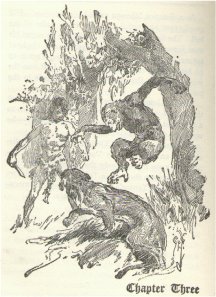
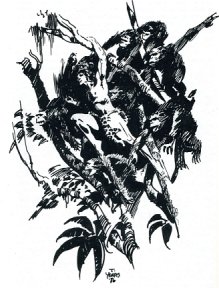
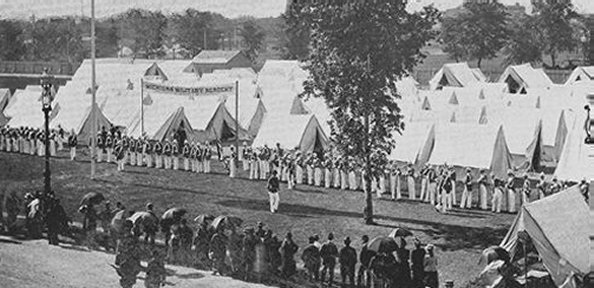
ERBzine's Young Ed Burroughs' Remarkable Summer of 1893
Chicago Columbian Exposition

A Review of
Stanley Galloway's The Teenage Tarzan
Adapted from the article “Prolific year for Bridgewater faculty.” by Bethany Funkhouser
The article appeared in the Bridgewater College Veritas, volume 9, issue 19 (29 April 2010), pages 6-7.What inspires a writer? Natalie Goldberg, an American author, said that “writers end up writing about their obsessions.”
For Dr. Stanley Galloway, professor of English, that obsession was Tarzan, the series and the character. His book, The Teenage Tarzan, published in January, gets its inspiration from a pastime he enjoyed as a fifth grader. He remembers complaining to his teacher at the time about wanting to read more Tarzan books.
She kindly sought them out in a neighboring town library. Throughout high school, Galloway, along with his older brother and a friend, used to get Tarzan novels and pass them around. By the end of high school, he said, he had read nearly all of the stories that were available.
Galloway forgot about Tarzan until graduate school, when his parents dropped off a box of books he had left at home. Around the same time the university library held a book collection contest. Galloway put together an entry revolving around his Tarzan collection, but did not win.
When he picked his collection up from the library, it had a note attached. The librarian suggested ideas on how to strengthen the entry for the next year. Galloway took the advice and purchased other kinds of editions and rarer articles related to Tarzan. He entered the contest again the next year and won.
“That’s when I thought maybe there is something about Tarzan that is worth pursuing,” said Galloway.
Now, Dr. Galloway’s office is decorated with his collection, and a large glass showcase houses some of his rarer pieces. In addition to collecting tangible Tarzan memorabilia, Galloway became somewhat of an expert on the topic. He spoke about Tarzan at several conferences.
He remembers one in particular, a conference in 2002, where someone suggested he write a book.
“I thought that’s crazy, why would I do that? It’s a lot of work. But then I realized I could because, in lecturing, I realized that I do know more about the topic than a lot people do.”
Galloway applied for a faculty research grant, which began in 2004, and used the funding for further research. Galloway describes many highlights of his research, but one of his favorite opportunities was meeting the grandson of Edgar Rice Burroughs, the original author of the Tarzan stories, in Tarzana, Calif. The grandson, Danton Burroughs, has since passed away.
The Teenage Tarzan is set up as a question and answer book. It revolves around Burroughs’s short stories, which deal with early tales of Tarzan. Galloway describes them as a formative time in Tarzan’s life; hence, the origin of the book’s title.
Galloway feels that each story in the collection asks the question, “who am I?” Each story gives another facet of the answer to that question.
Galloway’s book sets up each chapter based on one of the stories in the Burroughs collection, with the exception of two chapters where stories are combined.
Each chapter assumes a question. For example, one chapter asks the question “what is it, a man?” Galloway then explores the turn of the century perception of apes using anthropological literature from the day.

UNVEILING OF THE THOMAS YEATES COVER ART
ECOF 2009 ~ May 29-31
El Dorado Hills, California
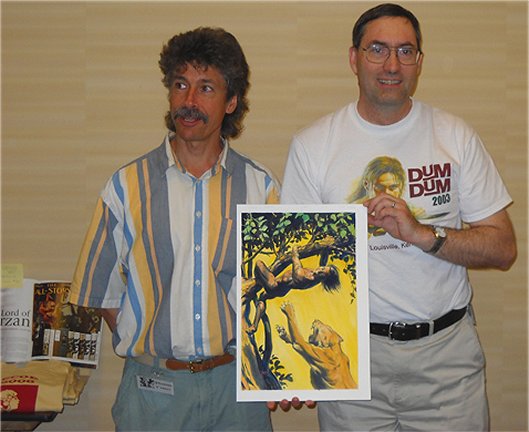
From A Photo Tour by Cathy Wilbanks and Janet Mann of ERB, Inc., Tarzana, California: ERBzine 2290
Thomas Yeates and Stan Galloway
Presenting Yeates cover art for the soon-to-be-released Galloway book
Visit the Thomas Yeates Tribute Site
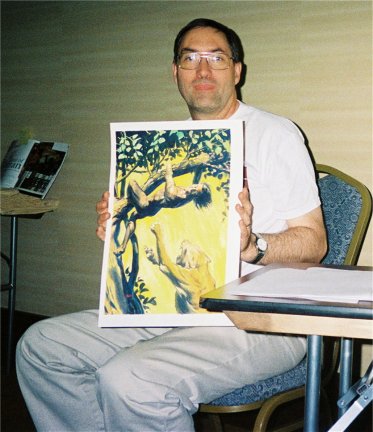
From ECOF photos by Huck Huckenpohler: ERBzine 2277
Stan Galloway with Thomas Yeates art
commissioned for the cover of The Teenage Tarzan.
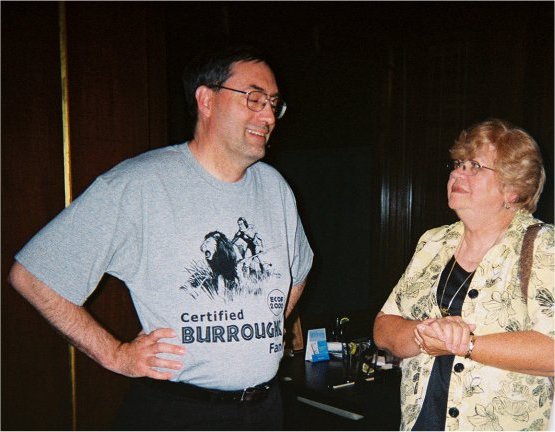
From a Photo Tour by Huck Huckenpohler: ERBzine 2275
Stan Galloway and Janet Mann of ERB, Inc.
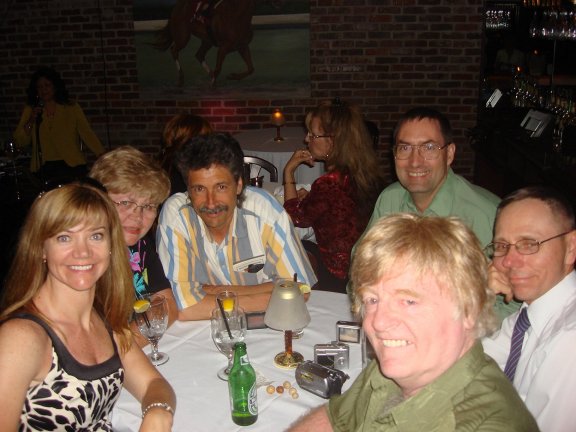
From the Danton Burroughs Memorial Tribute by Bill Hillman: ERBzine 2190
Remembering Danton at Charlie G's, Tarzana, California 2008
(clockwise from left)
Cathy Wilbanks ~ Janet Mann ~ Thomas Yeates
Stan Galloway ~ Henry Franke ~ Bill Hillman

WEB REFS
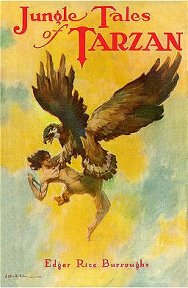
See the text of J. W. Buel's Heroes of the Dark Continent
complete with 8 art galleries in ERBzine
1813
ERB Personal Library
Paul du Chaillu: Explorations
and Adventures in Equatorial Africa - 1861
Thomas Yeates Tribute Site
Chicago Columbian
Exposition
Early Influences on Edgar Rice Burroughs Series:
Paul
Du Chaillu's Explorations and Adventures in Equatorial Africa: Art Galleries
![]()
.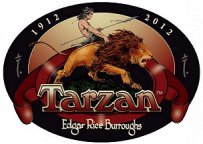
![]()

![]()
BILL
HILLMAN
Visit
our thousands of other sites at:
BILL
& SUE-ON HILLMAN ECLECTIC STUDIO
ERB
Text, ERB Images and Tarzan® are ©Edgar Rice Burroughs, Inc.-
All Rights Reserved.
All
Original Work ©1996-2010 by Bill Hillman and/or Contributing Authors/Owners
No
part of this web site may be reproduced without permission from the respective
owners.